I posted about a month ago that I was going to be doing some food fermentations and posting them to this blog, this is the first of those posts. I’m not sure how much food fermentation I will post on here, I suppose all the experiments I attempt, but this is something that I’ve wanted to start for a long time. Vegetable fermentation is new territory to me entirely so I’m going to start slow and build up some momentum.
For those of you that don’t know me personally, I am a passionate gardener. There are few things in life I care about honestly. I love my family (wife and kids), I love beer, I love gardening, I love science (specifically biology, chemistry and physics) and that’s about it. Every year my garden gets a little bigger. 2014’s garden saw the planting of 20 tomato plants, 16 chile pepper plants, beets, carrots, broccoli, kale, cabbage, spinach, corn, lettuces (6 different kinds), cucumbers, zucchinis, eggplant (two kinds), a dozen different herbs, parsnips, rutabaga, turnips…and so on…I can all the food that we can’t eat and we use it during the winter, to make matters mildly sillier, all of my gardens are raised bed gardens and two of them get covered with thin transparent plastic so I can keep growing past the point of freezing in the winter. I might be obsessed. I don’t doubt that one day I will live on a small farm.
Every year I make “estate salsa” which is what I call salsa made from ingredients I grow exclusively in my gardens (did I mention onions above? Cause there’s lots of onions as well…several kinds). The Estate Salsa are not fermented foods though, they are chopped vegetables cooked in a pot and canned into jars and stored for the coming year. This year, after reading about some pepper fermentation techniques, I decided to take the plunge and divert some of my pepper crop to the production of fermented sauces.
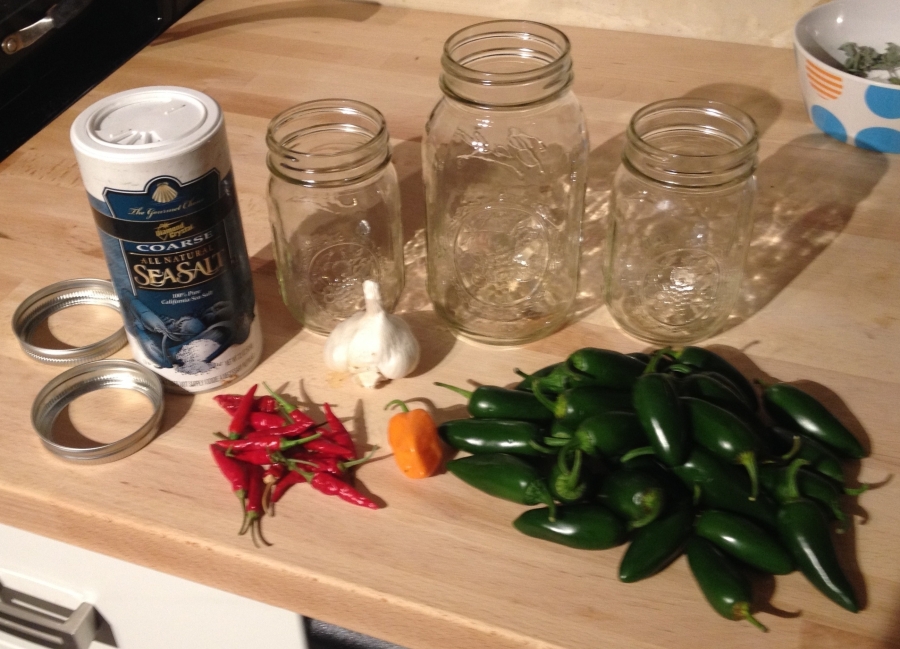
Recipe and Procedure for the Jalapeño hot sauce
I have no shortage of jars in my house but I did order some lids that have holes drilled in them and grommets added so a standard airlock can be used. It was a little silly to order this piece but they were cheap so I don’t care. This year, the peppers stalled and didn’t come in as early as years previous and I got worried. There were four jalapeño plants and one habanero plant. There is also two ancho chile plants, a tabasco plant and several bell pepper plants and a thai chile plant. This first round of fermentation is going to primarily be the jalapeño as those are the peppers I have the most of. I am throwing in some garlic, one habanero and a dozen of the little red peppers.
Ultimately I added about a pound of peppers (25 jalapeño and 1 habanero) total to a 32 ounce jar. I took some distilled water (no chlorine) and filled the jar such that there was a little bit of head space at the top and so all the peppers would be floating. I also added two whole cloves of garlic and a tablespoon of sea salt (non-iodized salt). I pitched about half a vial of WLP677 Lactobacillus brevis. The jar was placed at room temperature and allowed to ferment.

Notes on Fermentation
Fermentation was started on September 5th, 2014 with the addition of half a vial of WLP677 Lactobacillus brevis. The second half of the vial was held back for long term storage and for additional fermentation.
September 9th, 2014 – the dark green of the jalapeños is fading, starting at the stem end (the cut end) and approaching the tips. The jar smells strongly of garlic and there is noticeable bacterial growth within the solution.

September 24th, 2014 – I checked the fermentation several times over the course of the weeks. I had no idea what to expect and I was curious. I went away to Chicago for a weekend and came back to this…a pellicle had formed on the top of the peppers. I did not expect that but it is not reason to alarm at all. Several of the peppers have sunk to the bottom of the jar as well. I think I will wait until all or nearly all the peppers are at the bottom of the jar before I proceed further.
December 4th, 2014 – I let this sit for a couple of months while life got busy and I started two additional fermentations (described below), the pellicle is still there and the peppers and garlic sank to the bottom of the jar. It smells strongly of jalapeños and garlic…to be expected. There is a lot of sediment at the bottom of the jar, looks like bacterial growth to me. I think it is done.
December 6th, 2014 – It is time to blend the sauces up and bottle them. I poured the sauce into the blender and pureed the peppers and then passed the material through the strainer.
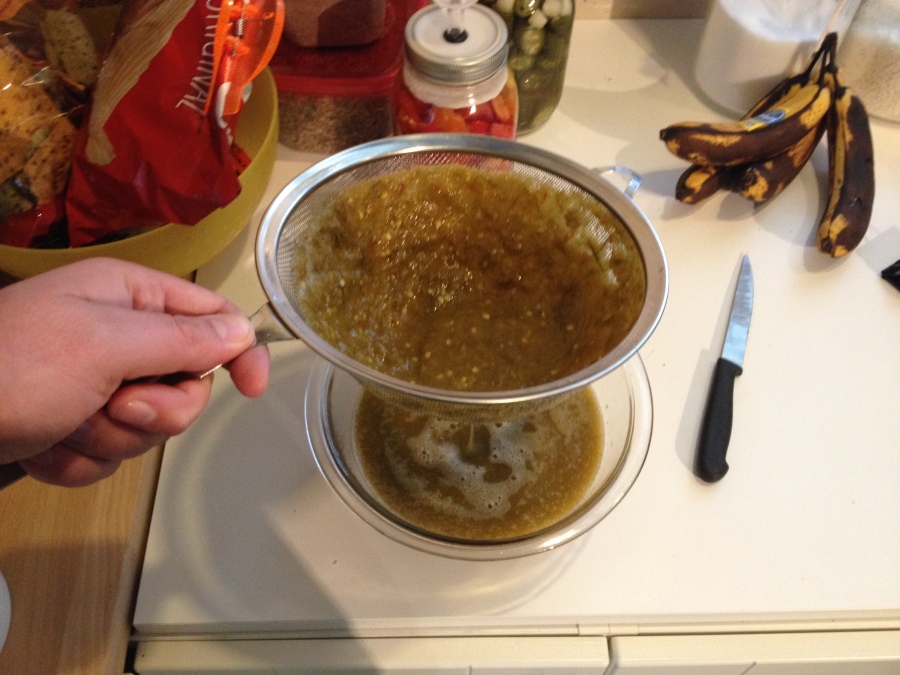
The final color of the sauce was dingy green, almost brown. A sort of army green. The second all green pepper sauce (described below) turned out a little greener and less brown but this one is definitely brownish greenish. Still, it smells amazing. Let’s see how it tastes.
Tasting Notes
Sauce #1: The color of this one is sort of a dingy, green, brown. This is probably due to the red, green, and orange peppers in this one. Not too far off from the greener hot sauces, just a little browner (there is a picture of all three sauces discussed in this blog at the end). Lots of peppers and acid in the nose, minimal garlic. There are hints of sweetness. The taste, here we go…this sauce has a nice saltiness to it, I took a couple of sips of the sauce alone. The spice hits me most in the back of the tongue. It has a nice mild garlic flavor but the spiciness is quite dominant and lingering. Very strong, very strong. This is above the level of say a Sriracha considerably. On a scale of 1 to 10 (where 10 is unusable) this is curently a solid 9. Very strong. The acid is a nice touch though…my eyes are sweating.
Overall, I think this will be a nice novelty sauce for my personal use but I won’t be giving this to anyone that doesn’t already love spicy food, love isn’t a strong enough word there. Needs capsaicin to live? If you need it to live, shoot me a message, we can work something out. This borders on poison…I am in fucking love.
What beer goes with spicy food? Oh right…none of them.
Possible Improvements for Future Attempts
In the future I think I will dunk the peppers in a sanitizing solution before putting them into the jar. The salt keeps yeast / mold from growing and there is an airlock so air can only escape the jar, minimal exchange with the atmosphere…it is just the microbiologist in me that thinks this should be more sanitized. I know people that freeze their vegetables to help break them down before starting a food fermentation but I know just as many people that do nothing…I’ll either freeze the next one I do or wash them in sanitizing solution…or both.
As far as flavor is concerned…well it is hot sauce. I usually cook illogically hot food for myself, so this makes me feel pretty good about how this turned out. My wife and kids will not be eating this one with me but I’m thinking more garlic and a milder pepper would make a nice sauce for someone like my wife. Or an apricot Habanero one….I need to write this stuff down.
Even though I’m wrapping up this sauce here, a month after I started this one I made a second sauce that I will also talk about in this post. Two-for-one? Yep.
Variations on a theme: Recipe #2 and #3 – Red peppers versus Green peppers

I decided to do a few of these to see what the difference were going to be. The one above was my first attempt and it was primarily jalapeño. This second one has jalapeño peppers but also a bunch of different peppers. Again, more garlic was added as well as sea salt and Lactobacillus brevis was pitched on top of that. I decided to cut the peppers a little bit before I started this one off…this might speed things up a little bit. More surface area, faster fermentation…at least I hope so.
I grew a starter of Lactobacillus brevis this time…propped up nice. The starter was about 250 ml of media specific for the growth of Lactobacillus. Here is the recipe:
5 g / liter — Yeast Extract
10 g / liter — Tryptone
20 g / liter — Dextrose
5 g / liter — Sodium Acetate
2 g / liter — Potassium Phosphate
2 g / liter — Ammonium Citrate
0.1 g / liter — Magnesium Sulfate
0.05 g / liter — Manganese Sulfate
The pH of the media was adjusted to 6.5. Cells were grown in a flask with aeration (shaking) at 37° C for 48 hours. Cells were crashed out at 4° C for 24 hours and the media was decanted and replaced with sterile water. The cells were divided between the red and the green jar.
Notes on Fermentation
October 14th, 2014 – This is my wedding anniversary so I decided to celebrate 8 years with my wife by making some hot sauce she will never touch. I took all the peppers from the garden that were ripe or ripe-ish and sorted them by color. I washed them with a gentle vegetable wash and then with water. I quartered them or diced them (for the big ones) and placed them in 32 ounce canning jars. I added 6-8 cloves of garlic to each jar as well. I filled the jars with water (fuller than I did the first one) and added 1.5 teaspoons of sea salt and then the Lactobacillus cultures. I fixed the airlocks and lids and placed them on the counter.
November 14th, 2014 – For whatever reason, the green sauce is outrunning the red. There is noticeable growth on the skins of the pieces and more of them have sunk while most of the red pieces are still floating. And a pellicle has formed on the green peppers but not on the red peppers. Both jars smell amazing, like hot sauce.
December 1st, 2014 – The red sauce has caught up with the green sauce and now has its own pellicle. Looks pretty good. The pellicle showed up a few days ago but now completely covers the peppers. The green peppers have almost completely sunk to the bottom of the jar. I think it is time to finally move these sauces forward.

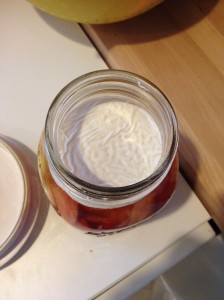
December 6th, 2014 – I poured each of the jars into a blender and passed the blended material through a mesh strainer into a bowl. The red was incredible red, bright…really nice looking. The green sauce is a little pea soup green, or army green. Here is a photo.

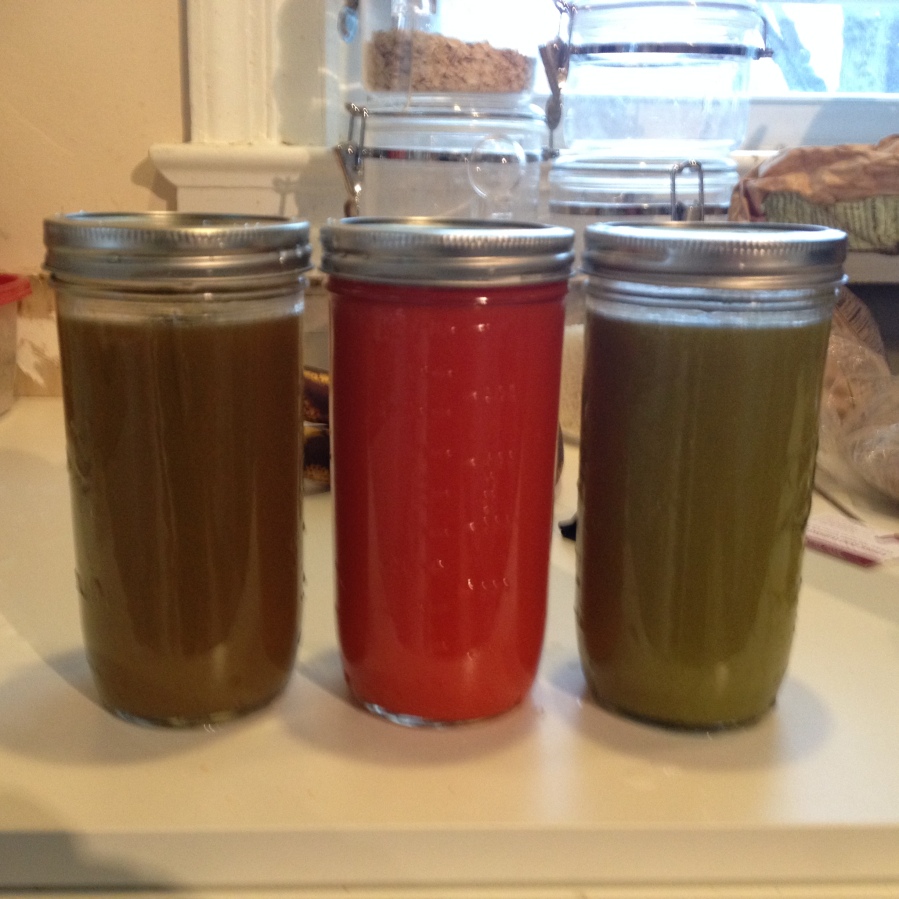
The red sauce had an incredible aroma of garlic and pepper, the green sauce made my wife cry and flee the room. Sorry love. Washing out the blender caused me to cough several times and my eyes were watering. The difference might reflect the fact that the red sauce had ancho and a type of bell pepper in it. Those might have affected the overall harshness of the aroma, even though both had a lot of hotter peppers.
Tasting Notes
Red Sauce (Sauce #2): First, this sauce looks amazing. Bright bright red, looks amazing. The aroma is a little sweet, nice garlic, nice pepper aroma, doesn’t smell especially spicy. I think the garlic is mitigating the harsh pepper spray aroma some hot sauces can get. I took some plain, salted potato chips for the taste test. The sauce is a thin, nice consistency. The flavor is definitely peppers, garlic and spice. On a 1 to 10 scale I’d give this version of the sauce a solid 6, 6.5. It is definitely spicy, not the spiciest of the three but it is pretty hot and it builds on you. Compared to commericial sauces, it is about at a Tabasco level of spicy with more garlic. It would be fun to play with this a little, cutting it with vinegar or some sugar or something.
Ultimately, this sauce is amazing. Not for everyone but what is? This is a great sauce to use anything that you want to be spicier, sparingly it can give a great heat, garlic, spice flavor to a dish but I’ll probably just use it on everything.
Green Sauce (Sauce #3): This is the greener of the two green sauces, the lack of red peppers in the fermentation allowed for this sort of light yellow / green to come through. This one smells more acidic, more like vinegar (no vinegar added). Less garlic, still there, much much more peppers. This sauce is pretty thin, good consistency. Much more spicy than the last one. It is the kind of spiciness that grows on the palate, almost drying out the mouth at the back. The garlic gives this a nice spiciness, I think the habeneros are coming through more in this one than the red sauce, really nice overall. Commercial comparisons, this is probably a little more spicy than Sriracha, it is in that neighborhood for sure. It lacks the texture of a Sriracha so it i shard to make a direction comparison but still…this is a great sauce.
On a scale of 1 to 10 (10 being unusable) this is an 8, aggressive, hot, but flavorful…not just spicy. I think this would also be a good one to play with, blend with different spices or flavors. Definitely a keeper.
Possible Improvements for Future Peppers sauces
Next year the pepper garden will put this year’s to shame, but first thing is first. I will be doing this again. I think I’ll try to do single pepper sauces next year, maybe just a serrano or just tabasco pepper sauce…Maybe I’ll barrel age some….unlikely though. I don’t have a lot to say in this section other than I’m looking forward to more of these experiments in the future. A spontaneous one might be interesting as well. Who knows, it will be about 6 – 12 months before I will attempt this again.
Upcoming posts
Next in this series? Breads. Sourdoughs three ways: spontaneous fermentation, lactobacillus culture, and lambic dregs. I also have a protocol to make a few different cheese but haven’t pulled the trigger on those. Saurkraut? Possibly. We will see.
Beer posts? A lot. I brewed 10 beers that haven’t been posted yet, production has been high, brewed today in fact. I’m going to post 1 a week for the next few weeks and then post 2 a week until I’ve cleared the docket. Lots of stuff coming up.
Author’s note: This post read a little redundant in places. It was written over the course of several months and underwent 24 revisions…hard to keep it together after so long. The future food fermentation posts will not be this redundant. Thanks for reading. Any advice, questions or suggestions, please leave a comment.
“There is an entire category of ultra-hot hot sauces that promises death. I recognize that death is a part of life. Still, I could not bring myself to endorse death by ultra-hotness, which is perhaps why my magazine found my piece quote unquote, ‘overly gay.'” – John Hodgman

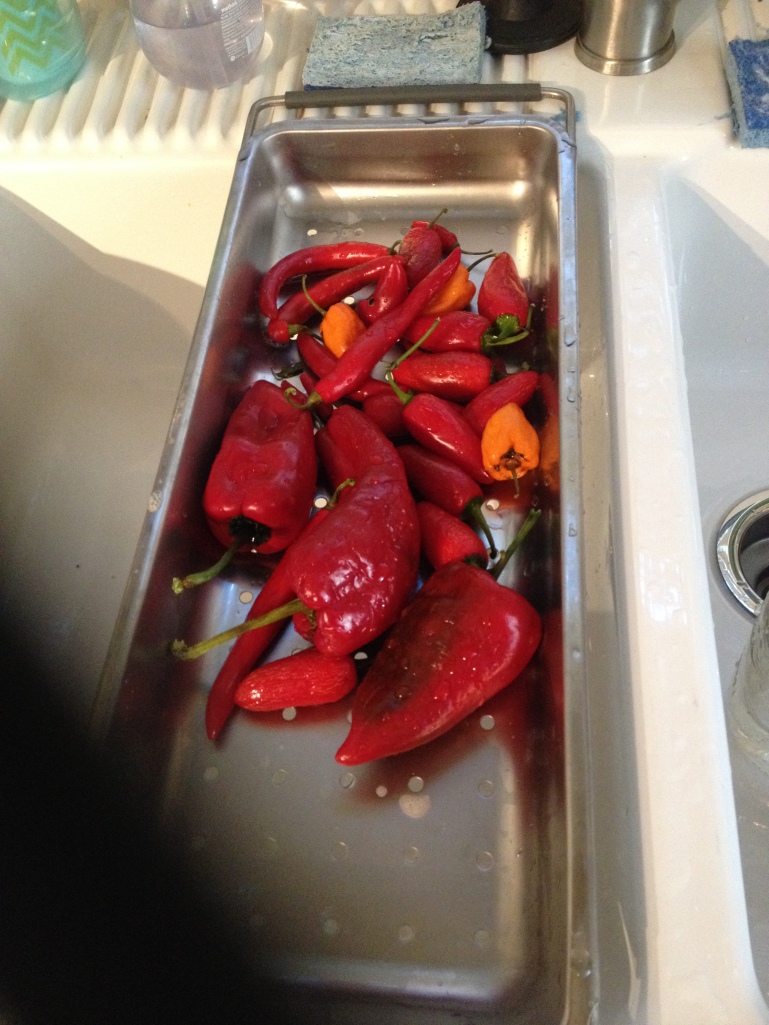
Great stuff- after I started brewing, I began to view the world in terms of fermentable/ not fermentable; nice to see some more of the fermentable things being fermented. A few thoughts, in no particular order:
(1) How did the hotness level compare to a medley of the same peppers not fermented?
(2) I wonder if it would help to acidify the “broth” prior to ferment (to 4 or 4.5 I think it is) like with sour worting to reduce other microbe growth?
(3) You could try varying the salt content, too. If you happen to have a copy, McGee in On Food and Cooking lists sauerkraut at 1-2%, kimchi at 3-4%, and lemons at 20%, along with a fair listing in between. I can send you the complete table if you like.
(4) I wonder what the pellicle is? I didn’t think lacto formed them.
– Dennis,
I’ll start with the lactobacillus comment first. It can definitely form a pellicle, I didn’t test this one to see what the culprit was but I have no reason to think it wasn’t Lacto at this point. I have specifically grown lactobacillus under anaerobic conditions and not shaking and they will eventually form a pellicle. In fact, most bacteria will form a pellicle of sorts…if given enough time. Also the pellicles that are in those three jars look shockingly similar and look like a bacterial not a yeast pellicle.
I did not hold back any peppers pre-fermentation this year. It is a good question. I have some peppers that I canned in vinegar that I suppose are close but obviously the acidity of those is going to be really high.
The acidification of the wort might help, honestly the salt should inhibit the mold / yeast growth and the really high pitch I gave these things should prevent very much side growth of other things….hard to tell. The second and the third got “washed” so any dose from the skins should have been low.
A table would be amazing if you can snap a photo of it. I’d love to see it. Or I can go looking for the book. Thanks for the feedback! I’m pretty pleased with this experiment. Hopefully I’ll get to do saurkraut this winter…cheese definitely.
I can’t recommend McGee’s book enough for all things science of cooking. I’ll snap a photo of the table- whats the best way to get it to you? I can email it if you drop me a line on my contact page. If you’re serious about cheese making, I would also recommend Karlin’s Artisan Cheese Making at Home. I like it better than Carroll’s.
– Dennis, Life Fermented Blog</a?
Multiple sites say the pellicle is contamination and it should be removed. Thoughts?
The peppers needed to be submerged below the brine as this is an anaerobic process; any veg matter in contact with air can start to grow weird stuff like this.
Great read, thank you! I’ve been doing some experiments with mixed lacto/brettanomyces home made hot sauce fermentation’s. I have a couple recipes currently fermenting, I may copy your airlock idea, as I’m using growlers right now and its getting a little crowded. I decided to puree the peppers before pitching the cultures, but I think I will also try it your way, then compare side by side to see if it makes a difference in flavors.